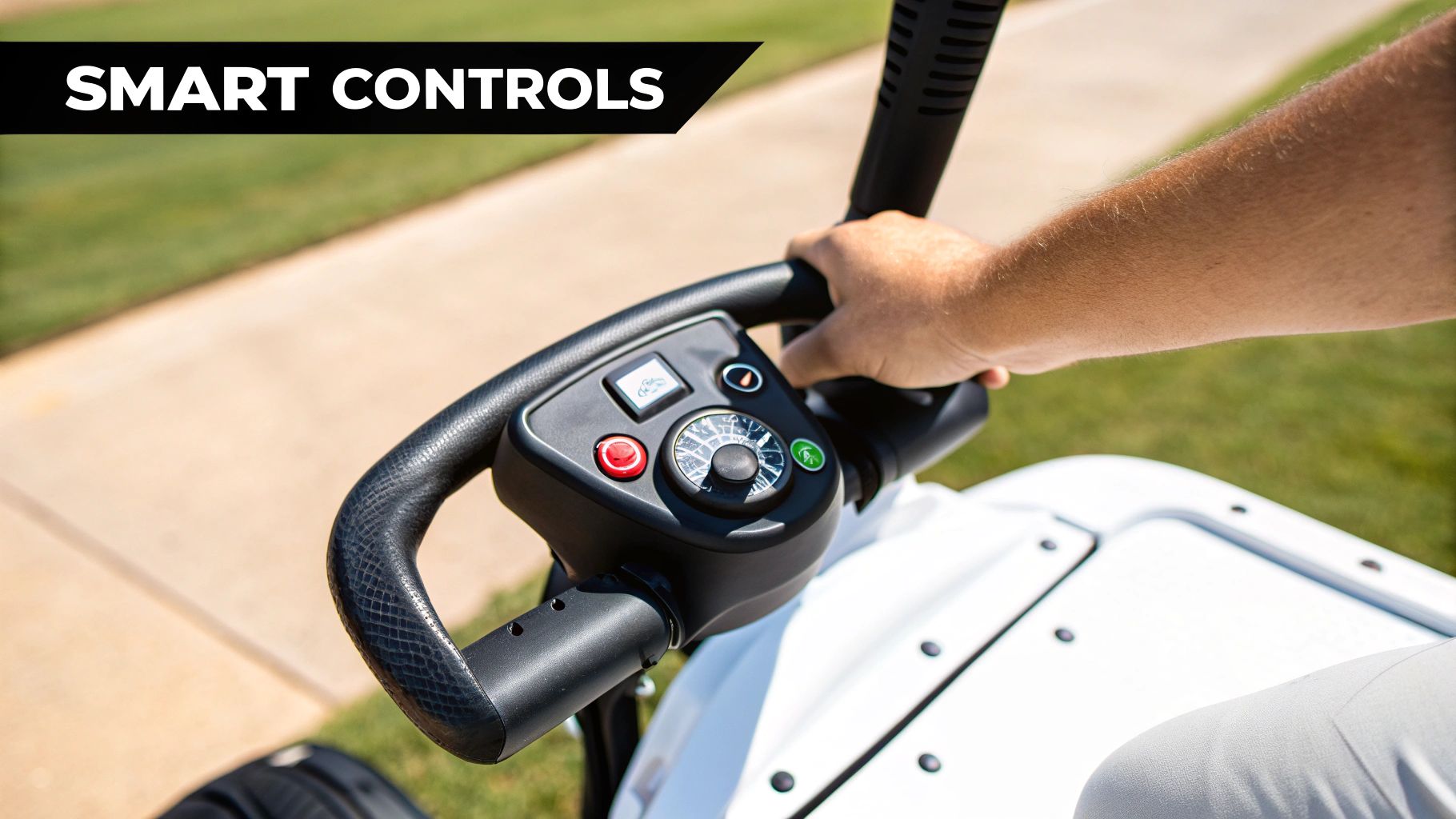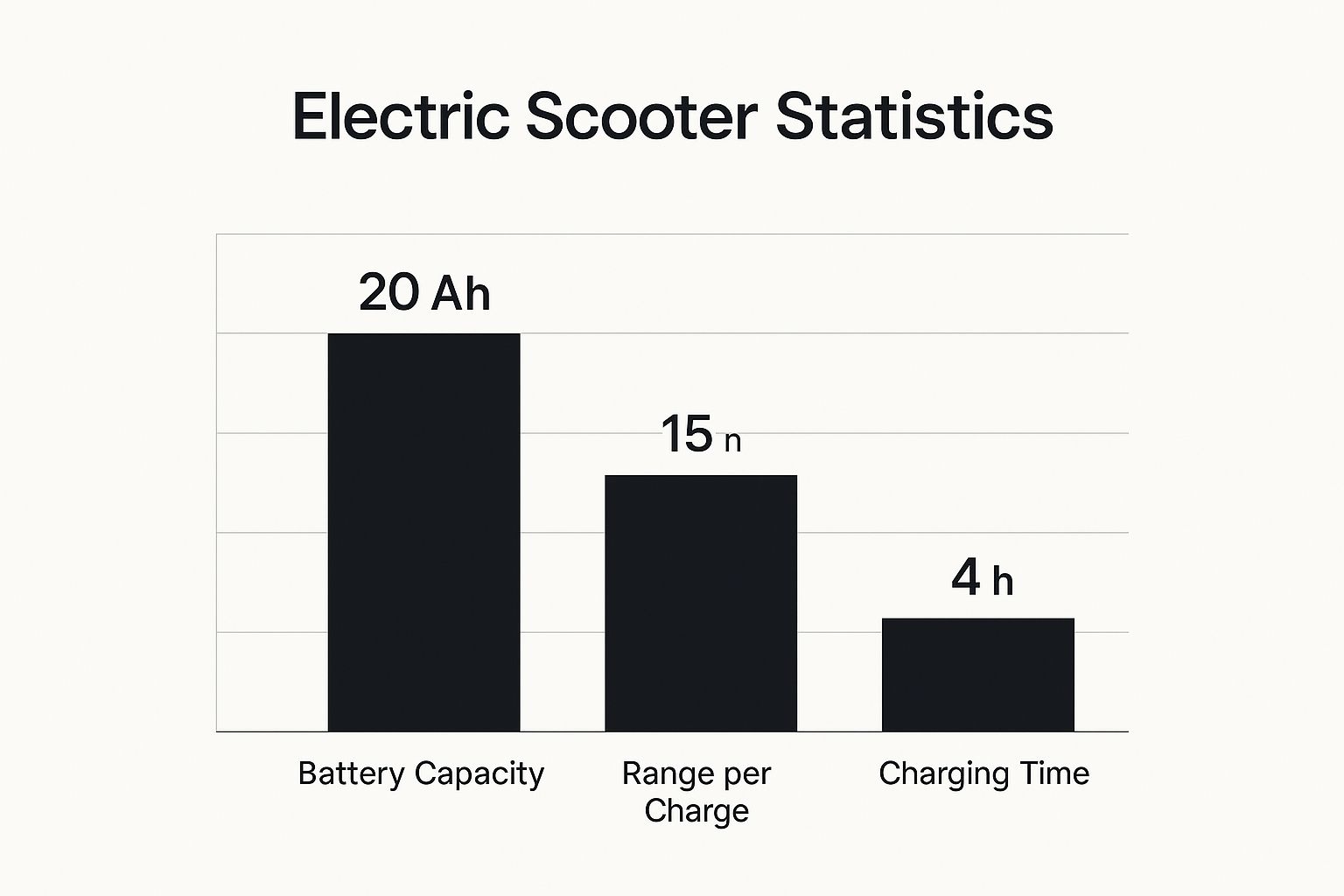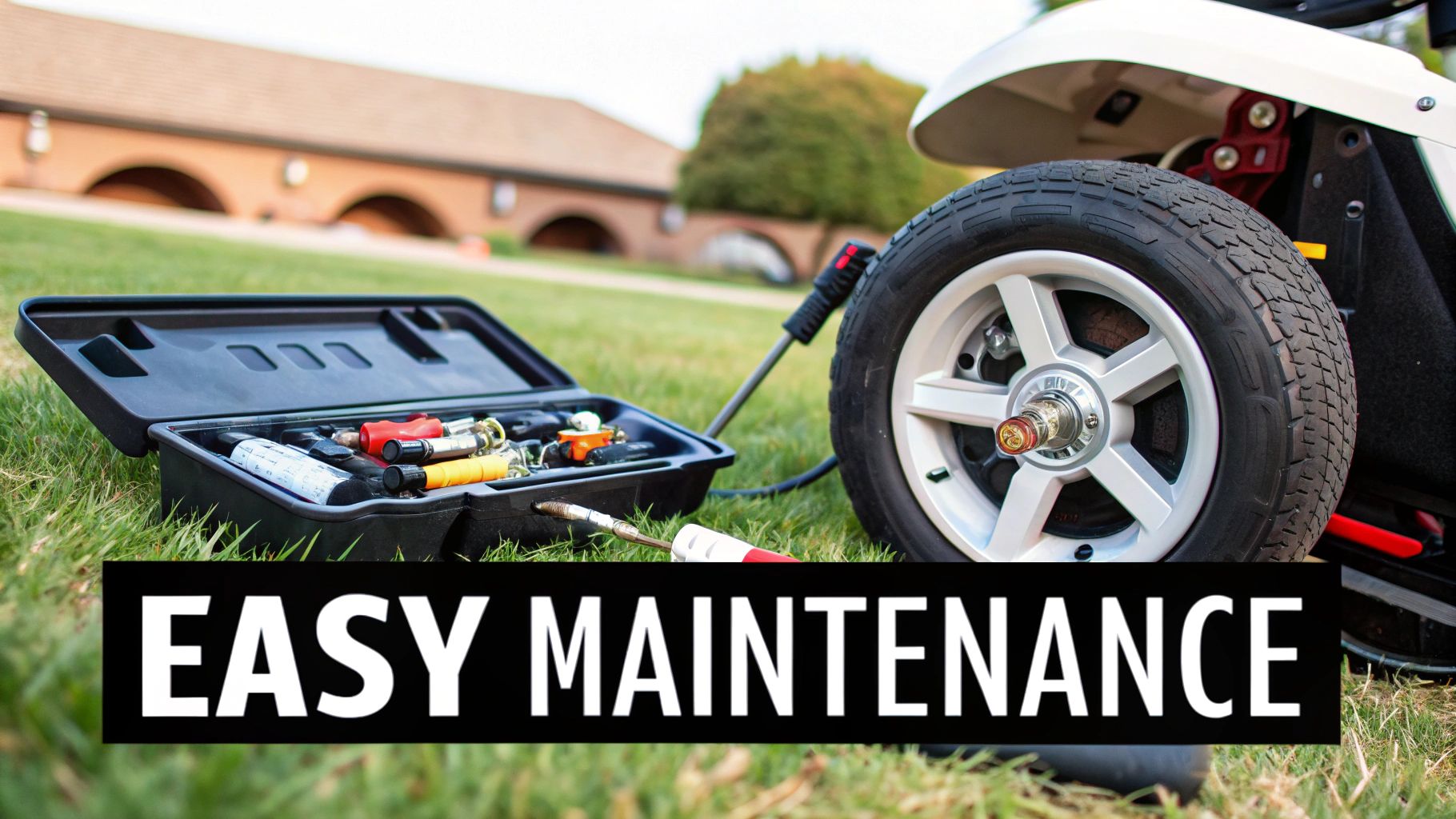An electric hand golf cart is basically a motorized trolley built to haul your golf bag for you. Think of it as your personal robotic caddy, freeing you up to walk the course without the physical grind of pushing or carrying your clubs.
Why Walk When Your Caddy Can Roll

Picture this: you're walking off the 18th green feeling just as fresh as you did on the first tee. That's the real promise of an electric hand golf cart. For years, walking golfers had two tough choices: lug a heavy bag and strain your back and shoulders, or shove a manual cart up and down hills, which is still a serious workout. That constant physical effort slowly chips away at your stamina and focus over a four-hour round.
The electric caddy completely flips that script. Instead of wrestling with your gear, you can pour all that energy into planning your next shot. It's your silent partner on the course, handling the grunt work so you can stay locked in on strategy and execution. It’s a small change that makes a massive difference, turning what was a physical chore into a relaxing walk.
Conserving Energy for a Better Back Nine
The real payoff hits you on the back nine. While everyone else is starting to fade from pushing or carrying their bag, you’re still physically sharp and mentally clear. That preserved energy translates directly into better golf when it counts the most.
- Reduced Physical Strain: Hauling a 30-pound bag can wreck your posture and fatigue your muscles, which absolutely impacts your swing. An electric cart takes that burden completely off your shoulders.
- Improved Focus: With fewer physical distractions, your mind is free to concentrate on club selection, reading the wind, and sinking that tricky putt.
- Enhanced Enjoyment: Walking the course becomes a much more relaxing and enjoyable part of the game, letting you soak in your surroundings and the company.
By offloading the work of carrying clubs, players can conserve an estimated 15-20% of their energy during a round. This saved energy is critical for maintaining consistency and power through the final holes.
The growing popularity of this gear is impossible to ignore. The global market for electric golf carts, including these walk-along models, was valued at USD 1.55 billion in 2024 and is projected to hit USD 2.58 billion by 2033. This shows a clear shift in how golfers are approaching the game, putting a premium on both performance and well-being. You can discover more insights on the electric golf cart market to see just how fast it's growing.
How Your Electric Caddy Works
Ever wondered what’s going on inside that electric caddy of yours? Let's pop the hood, but don't worry—we'll skip the complicated engineering jargon. At its core, an electric golf trolley is basically a very smart, very specialized remote-controlled car built just for the golf course.
The whole system is a brilliant team effort between three key players. Think of the battery as the fuel tank, the motor as the engine, and the control system as the brains of the operation. Once you see how this trio works together, you'll have a solid feel for the simple yet powerful tech that makes your walk so much easier.
The Power Source: The Battery
The battery is the lifeblood of your electric caddy. It’s what determines just how far and how long you can cruise before needing a recharge. You'll generally run into two types: the old-school Lead-Acid batteries and the modern Lithium-Ion ones. While they both get the job done, the difference in performance is night and day.
Lead-Acid is the heavier, older technology. They’re cheaper upfront, but they demand more maintenance, don’t last as many seasons, and take forever to charge. You don't see them much in newer, high-performance models anymore.
On the other hand, Lithium-Ion batteries are the gold standard now, and for good reason. They are incredibly lightweight—often 75% less than their lead-acid cousins—which makes a huge difference when you're lifting the cart in and out of your car. They also charge up much faster, give you more rounds over their lifetime, and deliver steady power right until the very end.
The Engine: The Motor
The motor is the workhorse here, turning the battery's electrical juice into the raw power that moves your cart and clubs. These compact but mighty engines are usually tucked away near the axle or even built right into the wheels. They’re designed to be whisper-quiet, efficient, and strong enough to tackle steep hills without breaking a sweat.
Most modern carts are kitted out with brushless DC motors. These are incredibly reliable and require virtually no maintenance, keeping your caddy running smoothly season after season. It's the motor's torque that lets your cart climb a steep incline with a fully loaded bag—a task that would have you gasping for air with a regular push cart.
This image shows the basic setup of an electric trolley system, which is very similar to what's inside your caddy.
You can see the fundamental parts—a power source, a motor, and wheels—that are just refined and adapted for the golf course in your trolley.
The Brain: The Control System
The control system is where the real magic happens. It’s what takes your commands and turns them into action, whether you're using a simple dial on the handle or a sophisticated remote that lets you direct your cart from across the fairway.
- Handle Controls: Your standard models will have a simple rotating knob or a set of buttons to adjust speed, stop, and start. It's straightforward and effective.
- Remote Controls: Step up a notch and you get a pocket-sized remote. This is a game-changer. It gives you the freedom to send your cart ahead to the next tee while you head to the green to putt out.
- Follow Technology: The most advanced systems feature "follow" modes. Using a series of sensors, the cart will literally follow you around the course at a set distance, giving you a completely hands-free experience.
Think of the control system as the cart's central nervous system. It constantly manages the flow of power from the battery to the motor based on your commands and the terrain, ensuring everything runs efficiently and responds the second you need it to.
Upgrade Your Game and Save Your Back

Choosing an electric caddy is about way more than just convenience. It’s a strategic move that pays real dividends for your health, your scorecard, and frankly, how much you actually enjoy your time on the course.
Let's break down the three biggest advantages you'll feel almost immediately.
The first and most obvious impact is on your body. Walking the course is fantastic exercise, but hauling a 30-pound bag for four hours puts a serious strain on your back, shoulders, and knees. An electric hand golf cart completely erases that burden.
Instead of fighting your gear, you walk the fairway with a natural, upright posture. This simple change cuts down on muscle fatigue and the risk of strain-related injuries, helping you finish the round feeling strong—not sore and wiped out.
Better Performance When It Matters Most
When you save all that physical energy, something amazing happens: it gets channeled directly into your mental game. Golf is a sport of intense focus and fine motor control, both of which disappear fast when you’re tired. By letting a motorized caddy handle the grunt work, you save your strength for your swing.
Think about the classic story of the golfer who plays a killer front nine, only to see their score balloon on the back. That drop-off is almost always caused by physical fatigue. Using an electric cart helps you maintain your energy from the first tee to the last putt.
This leads to some serious improvements:
- Improved Focus: A fresher mind makes smarter decisions on club selection and shot strategy.
- Stronger Finish: You’ll have the stamina to execute a powerful, controlled swing on the 18th hole, just like you did on the first.
- Greater Consistency: Less fatigue means a more repeatable swing throughout the entire round.
One golfer, Mark, used to struggle with his game completely falling apart after the 12th hole. After switching to an electric caddy, he found he had the energy to stay focused and shaved an average of three to five strokes off his typical score—just by not being exhausted.
The Sheer Convenience of Modern Caddies
Finally, you just can't overstate the effortless convenience these carts bring to the game. Modern designs are built around ease of use from start to finish. Setup is often a quick, one-click process, and handy features like remote controls and accessory docks for your phone or GPS make the entire experience seamless.
This demand for convenience and performance is why the market is booming. The U.S. electric golf cart market was valued at around USD 529.4 million in 2024 and is projected to hit USD 886.7 million by 2033. That kind of growth shows just how many golfers are embracing this technology to get an edge.
For a deeper dive into the specific advantages, check out our article covering the 5 benefits of electric push carts for golfers.
Choosing Your Perfect Electric Hand Golf Cart
Alright, you've decided an electric hand golf cart is the way to go. Smart move. Now comes the fun part: picking the right one for you. This isn't just about grabbing any motorized caddy; it's about finding a partner for your game—one that fits your style, your home course, and your budget.
Think of it like getting fitted for a new set of irons. You wouldn't just buy off the rack without considering what works for your swing. We're going to do the same thing here, breaking down the key factors like portability, battery life, and stability so you can make a confident choice.
And you're not alone in making this upgrade. The demand for these carts is booming. The North American golf cart market hit a value of USD 0.68 billion in 2024 and is expected to climb to USD 1.13 billion by 2033. That’s a whole lot of golfers ditching the heavy lifting for a smarter way to play.
Portability and Weight
Before your new caddy ever touches the fairway, it has to get from your garage to the course. This is where portability is king. You need to think about how easily it folds, how small it gets, and what it weighs. If it's a pain to wrestle into your trunk, you'll start leaving it at home.
The best modern designs have simple one-click folding systems and are built from light-yet-strong materials like aluminum. The goal is a cart that collapses into a neat package, leaving plenty of room for your clubs.

The numbers you see above are pretty standard for a solid mid-range model. It’s a great sweet spot, offering a good mix of power, range, and charging speed that works for most weekend warriors.
Electric Hand Golf Cart Feature Comparison
Navigating the options can feel overwhelming, so let's break it down. This table gives you a quick snapshot of what to expect at different price points, helping you match features to your budget.
| Feature | Entry-Level Models | Mid-Range Models | Premium Models |
|---|---|---|---|
| Price Range | $300 - $600 | $600 - $1,200 | $1,200+ |
| Battery Life | 18 holes | 18-27 holes | 27-36+ holes |
| Frame Material | Steel or Basic Aluminum | High-Grade Aluminum | Carbon Fiber or Titanium |
| Portability | Basic folding, often heavier | One-click folding, lighter | Ultra-compact, feather-light |
| Control System | Manual speed dial | Remote control, some with follow mode | Advanced remote, GPS, follow technology |
| Braking | Manual parking brake | Electronic parking brake | Automatic downhill braking |
| Stability | 3-wheel standard | 3 or 4-wheel options, wider base | 4-wheel, anti-tip designs, gyroscopes |
| Best For | Casual golfers on flatter courses | Regular players seeking balance | Serious golfers on tough terrain |
Ultimately, the best cart is the one that ticks the right boxes for your game. Whether you need a basic workhorse or a high-tech caddy, knowing what's available makes the decision much easier.
Battery Life and Range
The battery is the engine of your cart. It dictates how far you can go on a single charge. Will it last a full 18? What if you feel like playing 36? Most companies rate their batteries by the number of holes they can cover. 18 holes is the baseline, while 27-36 holes is a premium feature for the serious golfer.
- Standard Round (18 Holes): Most entry and mid-level lithium-ion batteries will get you through a full round without breaking a sweat, even on hilly tracks.
- Extended Play (27-36 Holes): If you’re an avid player who often goes for more than 18 or your home course is a monster, paying a bit more for an extended-life battery is a no-brainer.
Think of the battery's Amp-hour (Ah) rating like the size of the gas tank in your car. A higher number, like 20 Ah or more, means you’ve got more fuel for longer rounds and tougher climbs.
Stability on Hills and Terrain
Finally, take a hard look at your home course. Is it a flat, parkland-style layout, or are you navigating dramatic hills and uneven lies? Your cart's stability is a huge deal for both performance and safety. The biggest choice here comes down to three wheels versus four.
A three-wheel cart is typically more nimble and a bit lighter, making it easy to maneuver. But a four-wheel model gives you a wider, more solid base, which is a massive advantage on steep hills and awkward side slopes. Some top-tier models even include electronic downhill braking to automatically keep a steady, controlled pace for you.
And hey, once you've got the perfect cart, why not make it truly yours? You can find professional engraving services to add a custom touch. If you want to go even deeper on what to look for, be sure to check out our guide on everything you need to know before buying an electric golf push cart.
Exploring Smart Features and Advanced Technology

Today's electric hand golf carts are a world away from the simple motorized pushers of the past. They've evolved into sophisticated course companions, packed with smart technology designed to do more than just haul your bag—they actively make your round smoother and more focused.
From hands-free operation to on-demand course data, this new wave of tech turns your cart into a true digital caddy. It’s all about offloading the mental tasks and physical effort, freeing you up to dedicate your full attention to the game.
The Rise of Hands-Free Operation
One of the most impressive advancements is "Follow Me" technology. Imagine strolling down the fairway completely unburdened, with your cart trailing you like a loyal companion. It sounds like science fiction, but for many premium models, it's a reality.
Using Bluetooth signals from a remote on your belt and a suite of advanced sensors, the cart maintains a consistent distance, shadowing your every step. It starts when you walk and stops when you do, freeing you entirely from steering. This feature truly transforms your walk into a hands-free stroll.
Another game-changer, especially for hilly courses, is downhill braking control.
- Automatic Speed Regulation: Think of it like cruise control for hills. This system automatically applies resistance to the motor, maintaining a steady and safe walking pace on declines.
- Enhanced Safety: It stops the cart from getting away from you on steep slopes, giving you total confidence on even the most challenging terrain.
These systems ensure your cart is always perfectly under control, whether it's right behind you or you've sent it ahead with the remote.
Integrated Tech for a Smarter Game
Beyond just movement, the best electric hand golf cart models now integrate technology that can directly inform your shot-making decisions. This is where your cart becomes an invaluable source of information.
Many high-end carts now feature built-in GPS screens right on the handle. These displays give you precise yardages to the front, middle, and back of the green, plus distances to hazards like bunkers and water. Having this data instantly available means no more fumbling with a separate GPS watch or rangefinder.
This integration is more than a convenience; it streamlines your pre-shot routine. With distances readily available, you can make faster, more confident club selections without breaking your focus.
On top of that, many models now offer smartphone app integration. This connectivity unlocks a new level of personalization and data tracking. Through a dedicated app, you can:
- Remotely steer your cart, which is incredibly useful for sending it to the next tee box while you putt out.
- Track your stats, including walk distance, pace of play, and round history.
- Receive notifications for things like a low battery or maintenance reminders.
These smart features represent a massive leap forward, turning a simple piece of equipment into a powerful tool that helps you play better and enjoy the game more.
Keeping Your Electric Caddy in Top Shape
An electric hand golf cart is a serious investment in your game, and just like any other piece of high-performance equipment, it needs a little TLC to keep it running smoothly. The good news? A little bit of care goes a long, long way.
Think of it as a quick tune-up for your most reliable playing partner. Taking a few minutes before and after your round ensures your caddy performs flawlessly for years and helps you dodge those frustrating mid-round breakdowns. We're talking about simple habits that protect the most vital parts—the battery, frame, and wheels.
Essential Maintenance Checklist
Before you even think about stepping up to the first tee, get into the habit of a quick pre-round inspection. It's the best way to catch a small issue before it blows up into a major headache on the back nine.
- Tire Check: Are your tires properly inflated? A quick look is all it takes. Properly inflated tires roll smoother and help your battery last longer. Make sure there’s no visible damage, either.
- Frame and Joints: Give the folding mechanisms a once-over. Everything should feel secure, opening and closing smoothly without any hitches or sticking points.
- Clean Connections: A quick peek at the battery terminals is always a good idea. You're just looking to make sure they're clean and free of any gunk or corrosion that could interfere with the power flow.
Your battery is the heart and soul of your electric caddy. Simple, consistent charging habits are the single most effective thing you can do to get the most out of its lifespan and ensure it has enough juice for 18, 27, or even 36 holes.
Battery Care and Off-Season Storage
Your cart's battery is what needs the most attention, but the rules are pretty simple. Make it a habit to fully charge the battery after every single use, even if you only squeezed in a quick nine holes. Letting it sit completely dead for a long time is the fastest way to kill its capacity for good.
When the golf season winds down, how you store the battery is critical. Find a cool, dry spot for it, away from any extreme hot or cold temperatures. For a much deeper dive into getting the most out of your battery, our guide to golf cart battery maintenance has all the details you'll need. Taking these simple steps ensures your electric hand golf cart will be ready to roll the moment spring golf is back on.
A Few Common Questions
If you're thinking about making the switch to an electric hand golf cart, it’s smart to wonder how it’ll hold up in the real world. Let's tackle some of the most common questions golfers have so you can feel great about your decision.
How Long Does The Battery Last?
This is usually the first thing everyone asks, and for good reason! Most standard lithium-ion batteries will easily get you through a full 18-hole round on a single charge. If you like to play marathon golf, many of the higher-capacity models can push through 27 or even a full 36 holes before needing to be plugged in.
Of course, a few things will affect how much juice you get:
- The Course Itself: A hilly track with lots of climbs is going to use more battery than a flat, straightforward course.
- Your Golf Bag: Hauling a heavy tour bag loaded with gear takes more energy than a lightweight Sunday bag.
- Battery Age: Like any battery, its capacity will slowly fade over hundreds of charge cycles. It's a natural part of its lifespan.
Can It Handle Hilly Courses?
Absolutely. In fact, tackling hills is where an electric caddy really proves its worth. These carts are built for it, armed with powerful motors and smart braking systems designed for inclines and declines.
One of the best features you'll find is downhill speed control. This clever function automatically keeps the cart moving at a steady walking pace on the way down, so it never gets away from you. If your home course is exceptionally hilly, look for a model with a wider wheelbase or even a fourth wheel for that extra bit of stability.
An electric hand golf cart isn't just for flat courses. It's a powerful ally designed to conquer inclines, turning what used to be a tough climb into a simple, effortless walk.
Is It Safe To Use In The Rain?
Yes, you can definitely use your electric cart in the rain. The vast majority are built to be water-resistant, meaning all the important electronic bits are sealed up tight to keep moisture out.
While they can handle a steady drizzle without any issues, they aren't completely waterproof. You'll want to avoid dunking it in a pond, and it’s always a good idea to give the cart a quick wipe-down with a towel after a wet round.
Ready to transform your walk on the course? The Caddie Wheel offers a simple, powerful, and affordable way to motorize your existing push cart. Experience the freedom of walking 18 or even 36 holes without the fatigue. Learn more and upgrade your game today!


Share:
Finding the Best Rated Electric Golf Caddy in 2024
Master Your Cart Control Golf Remote